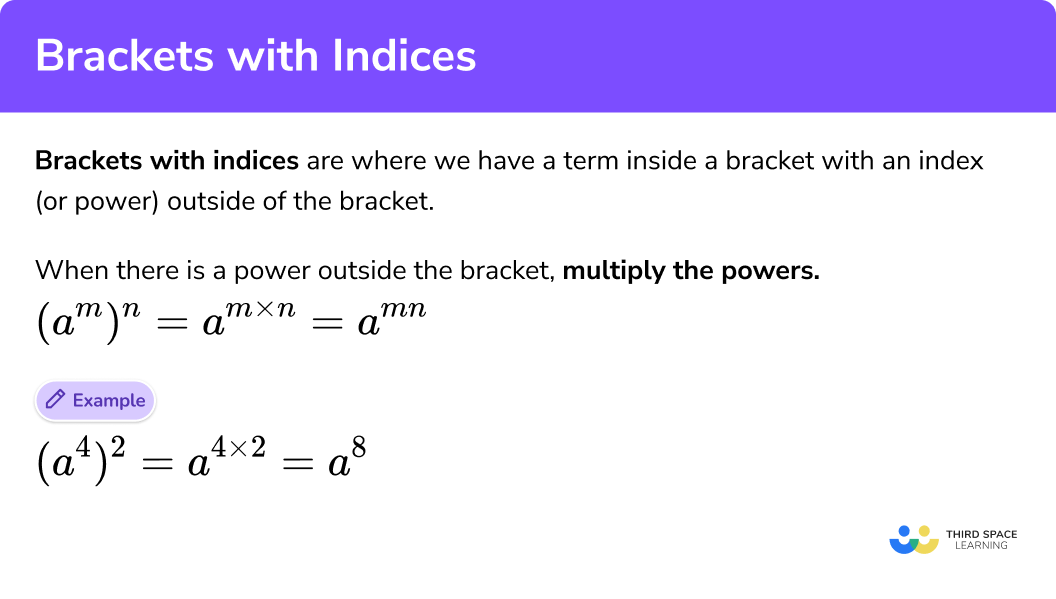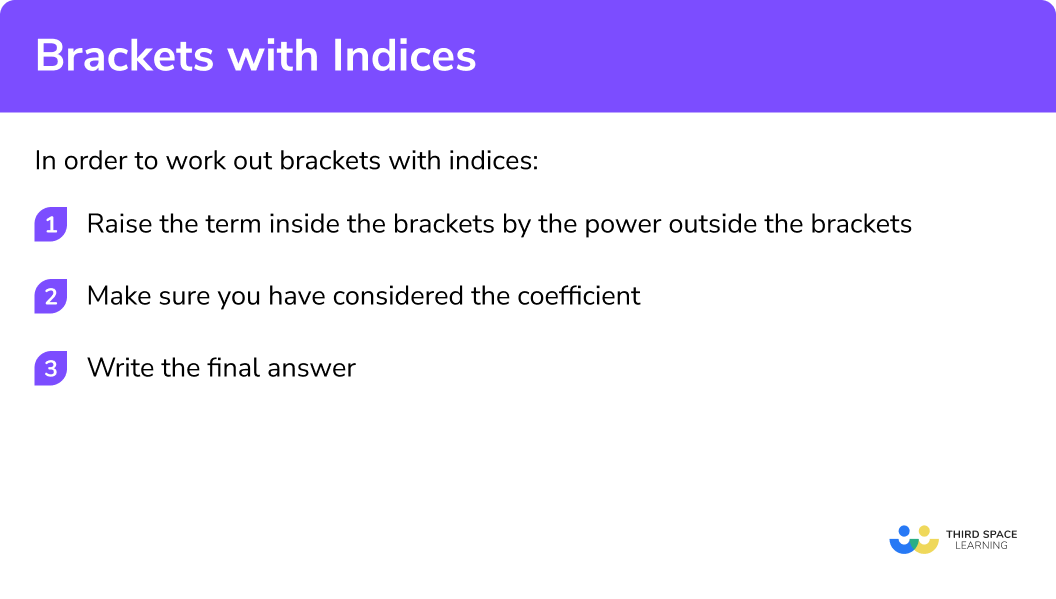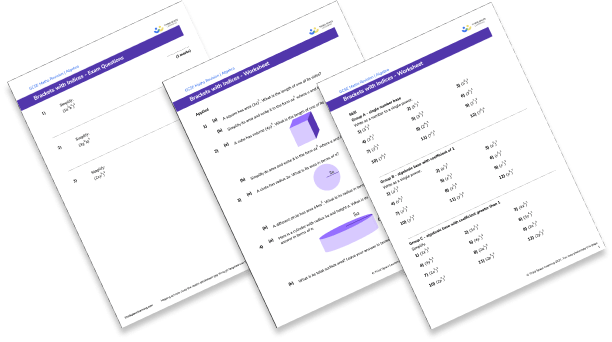GCSE Tutoring Programme
Our chosen students improved 1.19 of a grade on average - 0.45 more than those who didn't have the tutoring.
This topic is relevant for:

Brackets With Indices
Here we will learn about brackets with indices.
There are also laws of indices worksheets based on Edexcel, AQA and OCR exam questions, along with further guidance on where to go next if you’re still stuck.
What are brackets with indices?
Brackets with indices are where we have a term inside a bracket with an index (or power) outside of the bracket.
To do this we can raise everything inside the bracket to the power.
E.g.
We could also have used the multiplication law of indices.
However, a quicker method would be to multiply the indices:
In general when there is a term inside a bracket with an index (or power) outside of the bracket multiply the powers.
Brackets with indices is one of the laws of indices.
What are brackets with indices?

How to work out brackets with indices
In order to work out brackets with indices:
- Raise the term inside the brackets by the power outside the brackets
- Make sure you have considered the coefficient
- Write the final answer
How to work out brackets with indices


Brackets with indices worksheet

Get your free brackets with indices worksheet of 20+ questions and answers. Includes reasoning and applied questions.
DOWNLOAD FREE
Brackets with indices worksheet

Get your free brackets with indices worksheet of 20+ questions and answers. Includes reasoning and applied questions.
DOWNLOAD FREERelated lessons on laws of indices
Brackets with indices is part of our series of lessons to support revision on laws of indices. You may find it helpful to start with the main laws of indices lesson for a summary of what to expect, or use the step by step guides below for further detail on individual topics. Other lessons in this series include:
Brackets with indices examples
Example 1: single number base
Write as a single power of
- Raise the term inside the brackets by the power outside the brackets
It is quicker to multiply the indices (powers) together.
2Make sure you have considered the coefficient
There is no coefficient to consider.
3Write the final answer
The question asked for the answer to be as a single power so the final answer is:
Example 2: single number base
Write as a single power of
Raise the term inside the brackets by the power outside the brackets
It is quicker to multiply the indices (powers) together:
Make sure you have considered the coefficient
There is no coefficient to consider.
Write the final answer
The question asked for the answer to be as a single power so the final answer is:
Example 3: algebraic base with coefficient of 1
Write as a single power:
Raise the term inside the brackets by the power outside the brackets
It is quicker to multiply the indices (powers) together:
Make sure you have considered the coefficient
The coefficient is
Write the final answer
The question asked for the answer to be as a single power so the final answer is:
Example 4: algebraic base with coefficient of 1
Write as a single power:
Raise the term inside the brackets by the power outside the brackets
It is quicker to multiply the indices (powers) together.
Make sure you have considered the coefficient
The coefficient is
Write the final answer
The question asked for the answer to be as a single power so the final answer is:
Example 5: algebraic base with a coefficient greater than 1
Simplify:
Raise the term inside the brackets by the power outside the brackets
You can split the term inside the bracket into the coefficient and the base with its index (power).
The base and its index is:
This is being raised to the power
It is quicker to multiply the indices (powers) together:
Make sure you have considered the coefficient
The coefficient is
Altogether it would be:
Write the final answer
The question asked for the answer to be as a single power so the final answer is:
Example 6: algebraic base with a coefficient greater than 1
Simplify:
Raise the term inside the brackets by the power outside the brackets
You can split the term inside the bracket into the coefficient and the base with its index (power).
The base and its index is:
This is being raised to the power
It is quicker to multiply the indices (powers) together:
Make sure you have considered the coefficient
The coefficient is
Altogether it would be:
Write the final answer
The question asked for the answer to be as a single power so the final answer is:
Common misconceptions
- When simplifying you do not need the multiplication sign between parts of a term
You do not need a multiplication sign between the coefficient and the algebraic letter.
So final answer would be:
- Make sure that you raise everything inside the brackets to the power outside the bracket
It is a common error to forget to raise the coefficient to the power outside of the fraction. In the example below, it is easy to forget to square the coefficient
Practice brackets with indices questions
1. Write as a number to a single power: (2^3)^4




2. Write as a number to a single power: (7^2)^3




3. Write as a single power: (x^4)^2




4. Write as a single power: (h^9)^7




5. Simplify: (2d^3)^2




6. Simplify: (5e^4)^3




Brackets with indices GCSE questions
1. Simplify (3p^3 q^4)^2
(2 marks)
for 2 of 3 terms correct
(1)
9p^6 q^8
for correct final answer
(1)
2. Simplify (2n^2 m^5)^3
(2 marks)
for 2 of 3 terms correct
(1)
8n^6 m^{15}
for correct final answer
(1)
3. Simplify (7xy^4)^2
(2 marks)
for 2 of 3 terms correct
(1)
49x^2 y^8
for correct final answer
(1)
Learning checklist
You have now learned how to:
-
Simplify brackets with indices
The next lessons are
Still stuck?
Prepare your KS4 students for maths GCSEs success with Third Space Learning. Weekly online one to one GCSE maths revision lessons delivered by expert maths tutors.

Find out more about our GCSE maths tuition programme.